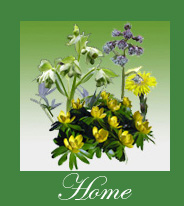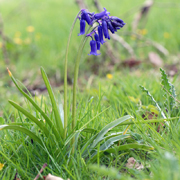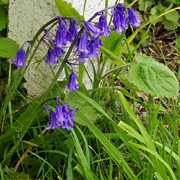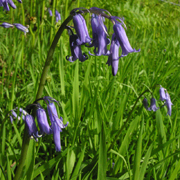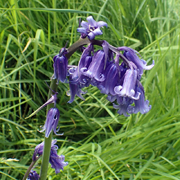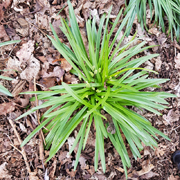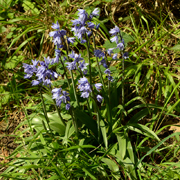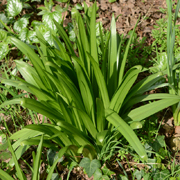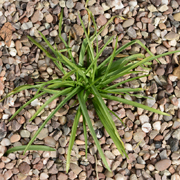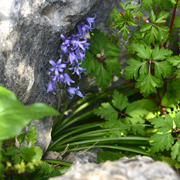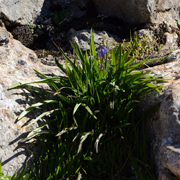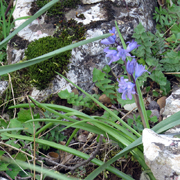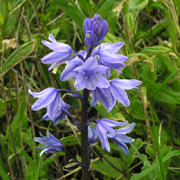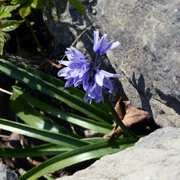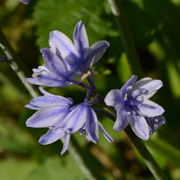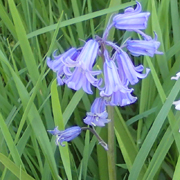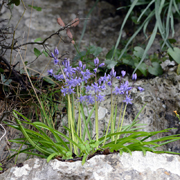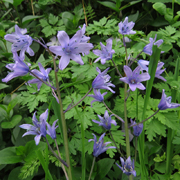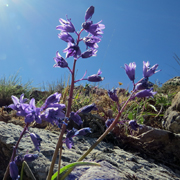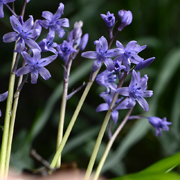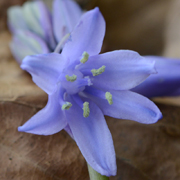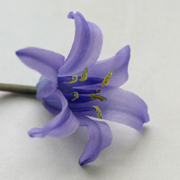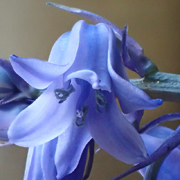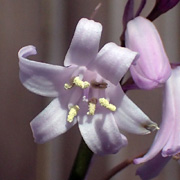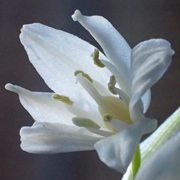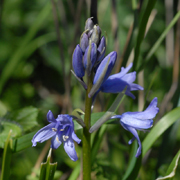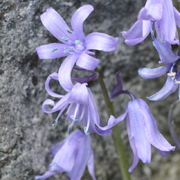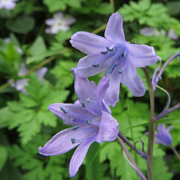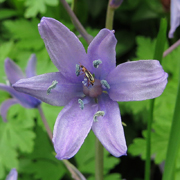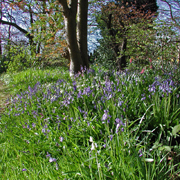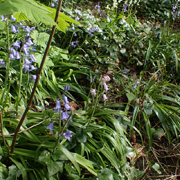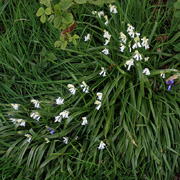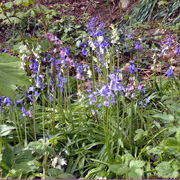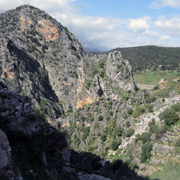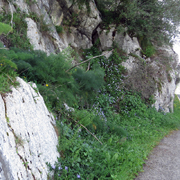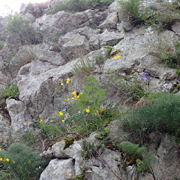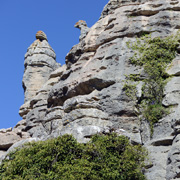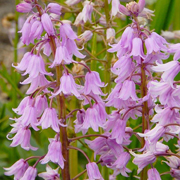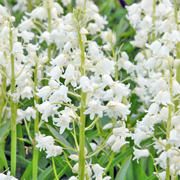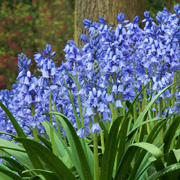Each Spring during the past decade or so, stories have appeared in newspapers, natural history magazines and sometimes even on television about the threat to the native Bluebell (Hyacinthoides non-scripta) in Britain and Ireland from non-native invaders: the Spanish bluebell and the Garden or Hybrid bluebell. This article attempts to show the characteristics of these various bluebells, how we might distinguish our native bluebell from the others and whether there is any substantial evidential threat to its existence from these invaders.
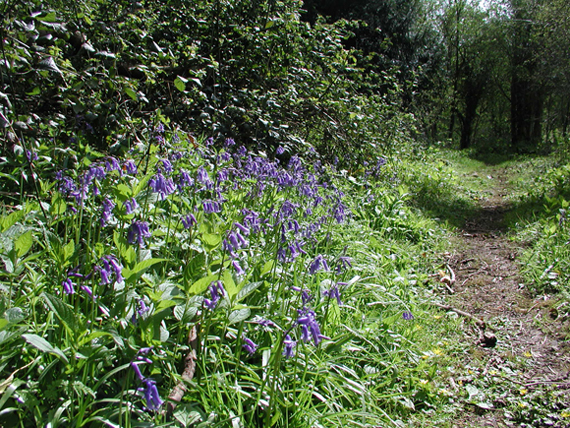
Native Bluebell
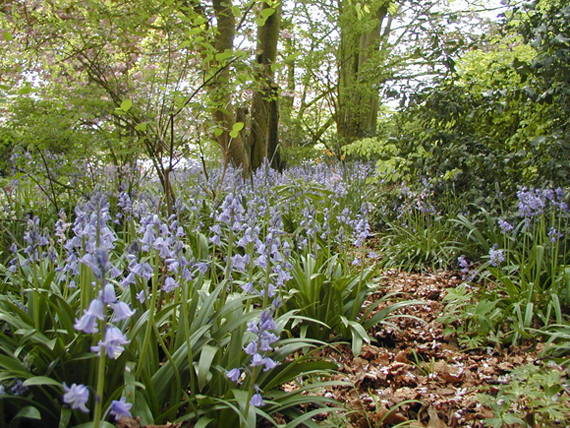
Non-native Bluebell
Our native bluebell: name changes
In 2002 Plantlife surveyed opinions about Britain's favourite wild flower in an attempt to find an appropriate and different wild flower to represent each County. The native Bluebell (Hyacinthoides non-scripta) was so popular in so many areas it had to be excluded from the list. Again in 2015, Plantlife surveyed thousands of its members to discover the favourite flower for the four nations of the United Kingdom. The bluebell was top of poll in England. Bluebells have been a favourite for a long time and gardeners have coveted their ability to form drifts of scented blue flowers in Springtime but trying to discover how long bluebells have been studied and cultivated is complicated by many name changes to the species over the years. World Flora Online21 describes 26 synonyms for the Latin name for Bluebell which have been used over the years. Here are a just a few of them:
| Botanical Synonym | Comments |
| Hyacinthus anglicus | This name was used in Gerard's Herball or Generall Historie of Plantes in 1597 by John Gerard and was applied to both taxa we now call the Native Bluebell (Hyacinthoides non-scripta) and the Spanish Bluebell (Hyacinthoides hispanica). |
| Hyacinthus non-scriptus (L.) | Carl Linnaeus1 (1701 to 1778) coined this name in his 1753 introducing the non-scriptus species name. The non-scriptus name comes from Greek mythology. |
| Scilla nonscripta Hoffmanns. & Link | Used in Neue Schriften, Gesellschaft Naturforschender Freunde zu Berlin. Berlin. iv. (1803) 19. |
| Agraphis nutans Link | From Handbuch zur Erkennung der Nutzbarsten und am Haufigsten Vorkommenden Gewächse. Berlin (1829) Agraphis means the same as non-scriptus (without words or writing) and nutans means nodding. |
| Endymion non-scriptus (L.) Garke | The genus name for bluebell was transferred to Endymion by Christian August Friedrich Garcke in 1849 in Flora von Nord- und Mittel-Deutschland. This was the name we all used when I started botanising seriously in the 1970s. Endymion in Greek mythology was the handsome son of Zeus. |
| Scilla festalis Salisb. | Used in Flowers of the Field by Rev Charles Alexander Johns in 1853 |
| Scilla nutans Sm. | Used in Flora of the British Isles by A.R. Clapham, T.G. Tutin & D.M. Moore 1989 |
| Hyacinthoides non-scripta (L.) Chouard ex. Rothm | The current (2021) name for our native Bluebell. First suggested by Pierre Chouard in 1934. |
Native bluebells and the link with Greek mythology
Carl Linnaeus first gave the first binomial name Hyacinthus non-scriptus to what we call now our native bluebell. This is because he recognised it as related to the Hyacinth which in turn takes its name from a Greek myth about a beautiful prince called Hyakinthos from a place called Amyklai near Sparta.
Hyakinthos was a follower of the God Appollon who loved Hyakinthos. One day Appollon and Hyakinthos were playing with a discus and Zephyrus the God of the West Wind, who also loved Hyakinthos blew the discus off course in a fit of jealousy. The discus hit Hyakinthos and killed him. At the spot where his blood fell on the earth sprang up a flower with markings on the petals. The marks seemed to spell out the word AIAI which translates as Alas from Ancient Greek. There are variations of this myth but they all involve blood being spilt and a flower growing as a result.
It is not certain what the flower was. Some say it must have been a type of Gladiolus, some say a Larkspur but not really anything like our familiar garden Hyacinth. Nevertheless the Bluebell is related to the Hyacinth so Linnaeus called it a Hyacinth (Hyacinthus). But our bluebell doesn't have the letters AIAI inscribed on the tepals (non-scriptus). After many attempts at re-naming the genus we have arrived at Hyacinthoides non-scripta. The - oides which is originally from Greek, can be incorporated into a Latin binomial for a plant. It means similar to, a bit like, looks like or resembles.
So a rough translation of our current scientific name for Bluebell tells you its a bit like a Hyacinth but without any writing on the petals.
Field Observations in this article
It is fair to say that amongst most practising field botanists, it has long been recognised that Spanish Bluebell (Hyacinthoides hispanica) has been over-recorded instead of the Hybrid (Hyacinthoides hispanica x Hyacinthoides non- scripta = Hyacinthoides x massartiana). As long ago as 1988 one of our most distinguished UK botanists, Dr. T. Rich2 wrote: "The True Spanish species is not often seen" .
However, that is not always how the situation is presented even by well known and respected plant organisations such as the Royal Horticultural Society, The Wildlife Trusts, National Trust or Gardeners World for example. Advice on how to distinguish Spanish from native bluebells tends to be the main thrust of the identification advice. And as if to reinforce the idea that Hyacinthoides hispanica is common in UK and Ireland, the current BSBI Atlas (March 2024) shows it to be quite commonly recorded.
So is Hyacinthoides hispanica commonly found in UK or not? At this point in the article we assume that it could be.
To avoid confusion in this article, the photos of Hyacinthoides hispanica were taken in Andalucia in Spain and the photographs of hybrids and native bluebells in UK. The aim of this article is to present actual original photographs of whole plant, leaves, flower stem and close-ups of the florets and habitat to try to reach a conclusion about the genuine morphological differences between these species.
When the article refers to non-native Bluebells, it means they are most probably hybrid bluebells (Hyacinthoides x massartiana) but could just possibly be Spanish (Hyacinthoides hispanica) . When it refers to native or Spanish bluebells, the article refers to Hyacinthoides non-scripta or Hyacinthoides hispanica definitely.
Note on how to use the photographs: If you have scripts enabled on your computer or mobile device then clicking on the thumbnail (180 x 180 px) photo will cause it to enlarge to 800 x 800px. It will not at first enlarge bigger then the screen on your device though. This limits the usefulness of this feature on some mobile devices and cell phones. On large screens you can enlarge more than one photograph at once and drag them alongside each other for comparison. Click the enlarged photo again to reduce it back to the thumbnail size.
Field Observations of Hyacinthoides non-scripta in Britain and Ireland
| Native Bluebell | Observed features |
|
Our native bluebell (Hyacinthoides non-scripta) is very often found in the company of hundreds if not thousands of others. It is sometimes difficult therefore to get a photograph of a single plant. This one, in a field on the edge of a large bluebell wood, shows the dark blue, tubular flowers, the nodding habit and the one sided inflorescence. The leaves here are fairly narrow but contrary to what you might read in other guides, leaf width alone cannot be relied upon as a distinguishing feature. Some non-native bluebells have leaves almost as narrow than the ones shown here. The leaf width of the native bluebell measured in this study did not vary much (().4cm to 0.6cm, rarely 1.0 to 1.5cm). |
|
|
A close view of the florets making up the inflorescence shows the deep blue/purple, elongated, bell-shaped flowers (tubular) with significant reflexing (curling back) of the tepals. The florets are always fairly crowded together at the top of the pedicel (flower stem). The nodding habit of the native bluebell means that most of the florets are pointing towards the ground making it tricky to see the pollen colour which is usually white/cream and sometimes described as pale yellow. |
|
|
In this plant the inflorescence is has fewer florets but they are still crowded at the top of the scape (flower stem). Just under each individual floret there are two narrow, pointed, purple bracts. Some of the florets here show reflexed (curled back) tepals but not as pronounced as in those photographed above. There will nearly always be some reflexing of the tepals in Hyacinthoides non-scripta. Again the florets point downwards so that the anthers and therefore the pollen colour, cannot be seen from above. |
|
|
In this case, a cold British Spring allowed bluebells to go on flowering much later than usual. This one is on the edge of a large coastal patch of bluebells rather than in a wood. The bluebells will eventually be shaded out by Bracken (Pteridium aquilinum). This close-up has one floret upturned so you can see the white pollen from the dehisced (opened ) anthers. The normal colour of the pollen is white in this species and does not vary. The colour of the flowers here is nearer purple or violet than dark blue but digital cameras sometimes have difficulty in accurately recording shades of blue and purple. |
|
|
At the edge of the woodland area the bluebells are more sparsely distributed enabling the photographer to get a shot of the leaves with no overlap from neighbours. This shows the very narrow, almost parallel sided leaves of the native Hyacinthoides non-scripta bluebell. Looking at the widest leaf and the narrowest in this particular bluebell wood, the range of leaf widths was measured to be 1.0 cm at the widest to 0.4 cm at the narrowest with most around 0.5/0.6 cm. |
Field Observations of non-native bluebells
There is general agreement that the native bluebell (Hyacinthoides non-scripta) can be distinguished morphologically (appearance/shape) from non-native species such as the Spanish Bluebell (Hyacinthoides hispanica), Spanish Bluebell cultivars and Hybrid Bluebells (Hyacinthoides x massartiana) and hybrid cultivars. There isn't one definitive character which will allow identification of our native bluebell but a combination (see Separating the non-native bluebells from the native Hyacinthoides non-scripta below).
The identification problems arise when you examine a range of non-native bluebells growing in Britain and Ireland seeking to find consistent distinguishing features to aid identification. As stated above, the only Spanish Bluebells photographs shown here are images taken in southern Spain but you can see from the distribution map that Hyacinthoides hispanica is also found in Portugal.
Although Hyacinthoides non-scripta and Hyacinthoides hispanica both occur in Spain and Portugal, Hyacinthoides non-scripta is confined to the north and a relatively small region of central Spain. Hyacinthoides non-scripta is not recorded from the Andalucian countryside so this reduces the chances of hybrids occurring naturally. Hybrids can be occasionally found in the absence of both parents though. Naturally occurring hybrids happen in Spain between the north bands of Hyacinthoides non-scripta and the Hyacinthoides hispanica further south.
Distribution of Hyacinthoides non-scripta and Hyacinthoides hispanica in the Iberian peninsula 4
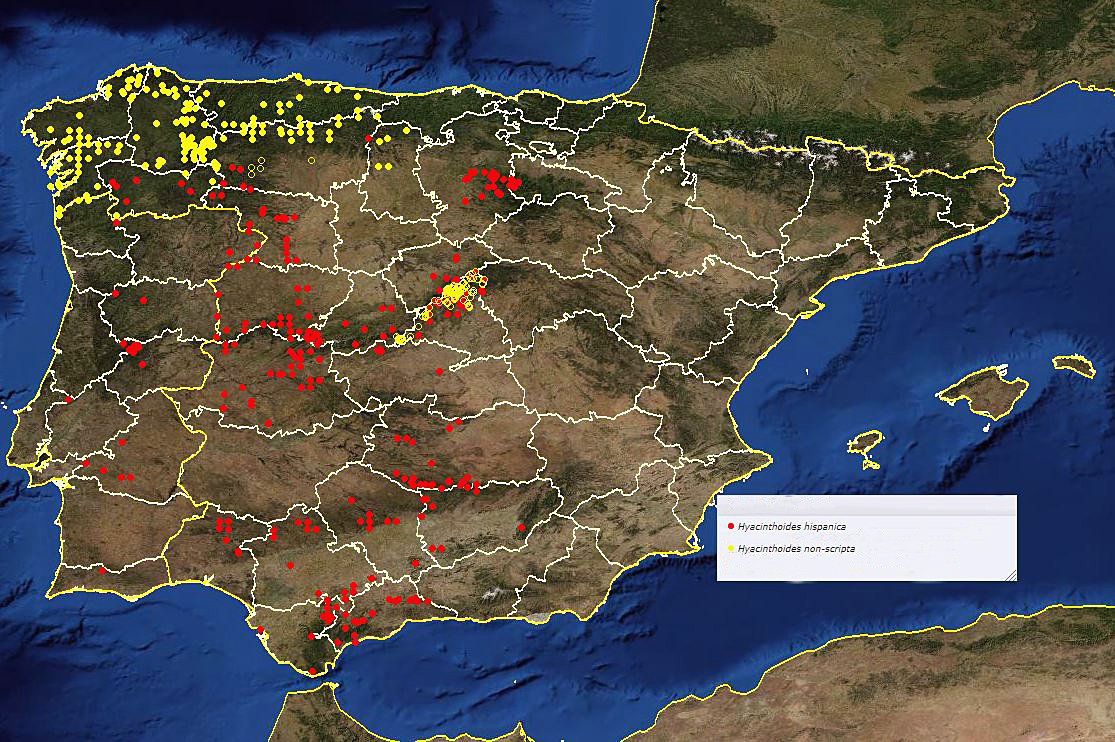
The other non-native Bluebells shown in the following table are from from gardens and various countryside locations in England and north Wales mostly not far from human habitation. All the measurements and photos are from field work not literature sources.
Comparing leaves of non-native Bluebells
| Non-native Bluebell in Britain/Ireland | Observed features |
|
A typical clump of non-native bluebells show an erect pedicel (flower stalk) and individual florets arranged all round the flower head. The leaves here are significantly wider than in Hyacinthoides non-scripta (Native bluebell). |
|
|
This is a Garden bluebell. Garden bluebells, too often sold as Hyacinthoides hispanica, are more likely to be hybridised after several generations so although bought with the label 'Spanish bluebell', they may well be hybrids. These plants are almost definitely hybrid bluebells. The widest bluebell leaves are found in hybrids (Hyacinthoides x massartiana) and this plant for instance had leaf widths ranging from 2.8cm to 4.5cm which is well outside the maximum range usually quoted for Hyacinthoides hispanica. |
|
|
Non-native bluebells are fertile and can backcross with each other. Some progeny can show more of the characters of one parent than the other. In this plant, the leaves are almost as narrow as the 0.4 to 1.0 cm range of a typical native bluebell. Using leaves alone as a clue, you might identify this plant as the native bluebell. When it flowers though, it is obviously a non-native bluebell. |
| Spanish Bluebell in Spain | Observed features |
|
This specimen of Spanish Bluebell has quite narrow leaves although not quite as narrow as Hyacinthoides non-scripta. Often Spanish Bluebells will have some wider leaves as well. This one only had narrow leaves. It was found growing near a limestone rock in the hills which is a typical habitat for this plant. |
|
|
Some leaves are quite wide and some significantly narrower in this clump of Hyacinthoides hispanica but all the leaves are wider and more erect than a typical Hyacinthoides non-scripta growing in Britain or Ireland. Even the widest of these Hyacinthoides hispanica leaves is not as wide as those found in some garden Bluebells. |
|
|
The leaves here are significantly longer and wider than any you would find on even the healthiest Hyacinthoides non-scripta. They are sometimes "pleated" with a V shaped profile. The photographs above of the Spanish Bluebell growing wild in Spain show that the assumption that Hyacinthoides hispanica always has wide leaves and that this is a distinguishing feature for identification, is incorrect. This may be because those characters are assumed to be those of H. hispanica but are actually from H. x massartiana. |
General characters of Inflorescence of non-native bluebells
| Non-native Bluebell in Britain and Ireland | Observed features |
|
This is a typical clump of non-native bluebells showing an erect scape and individual florets arranged all round the flower head. The leaves here are significantly wider than in our native bluebell (Hyacinthoides non-scripta). |
|
|
This closer photo of one non-native bluebell flower head again shows an erect scape and individual florets arranged all round the flower head. Each tepal has a distinct and blue stripe down the middle said by some to be typical of hybrid bluebells. |
|
|
This single non-native bluebell flower head again shows an erect scape (flower stalk) and individual florets arranged all round the flower head. The pollen colour here is blue as is often stated in identification guides. Such guides will then suggest Hyacinthoides hispanica as an identification but hybrids cannot be ruled out. |
|
|
Identification guides will often suggest that saucer shaped flowers are associated with pure Spanish Bluebell. In this non-native bluebell the flowers are mostly campanulate (bell-shaped) but one is opened very wide indeed. The outside of the petals show a distinct blue stripe rarely found in Spanish bluebells growing in Spain. They have blue pollen. This is typically the sort of non-native which may be recorded as Hyacinthoides hispanica even though it was growing in the middle of a population of much more obvious hybrid bluebells. |
|
|
Non-native bluebells can back-cross to yield a few offspring which are much closer to one parent than the other. This plant shows the longer more tubular bells, some reflexing of the tepals but without a one-sided flowering habit. The outside of the tepals show a distinct blue stripe which is rarely found in the pure Spanish Bluebell (H. hispanica) but is apparent sometimes in the native (H. non-scripta). |
| Spanish Bluebell in Spain | Observed features |
|
On a sunny day this clump of Spanish Bluebells were fully open with the flowers almost flat. The medium width leaves show the variability of this character. Florets are well spaced, campanulate (bell-shaped) at first with slightly reflexed tepals and with dehisced anthers (burst open) revealing blue pollen. The tepals in the fully open flower are well separated. |
|
|
This whole Spanish Bluebell has typically fewer florets and they are more spread out than in the typical hybrid (Hyacinthoides x massartiana). Fewer florets might be due to poor soil of course. Here, the pedicels (flower stalks) are longer than the native and many of the non-native bluebells found in Britain and Ireland too. The florets are at right angles to the pedicel, some even pointing upwards. There is only the very faintest blue stripe on the tepals. Compare this with illustrations or photographs in guides attempting to separate the native from the Spanish bluebell. Those guides often show densely pack flower heads with the campanulate florets pointing or drooping downwards. |
|
|
Most of the inflorescence of one plant is shown here demonstrating how often the florets of Hyacinthoides hispanica can often be quite sparse, on short pedicels (flower stems) and spread all round the plant and at right angles to the flower stem or even pointing slightly upwards. |
|
|
A large clump of Spanish bluebells growing from a crack in rock. Even in late March or April the Spanish sun can be very hot and allows the floret to open almost flat. The flowers show variable reflexing (curling back) of the well separated tepals and all anthers have blue pollen. The anthers on several florets shown here are undehisced (pollen still inside the anther) and so appear a slightly deeper blue colour and arrow shaped. Again the scape has relatively few florets compared with a typical non-native garden Bluebell found in UK. |
Single floret close-ups
| Non-native Bluebells in Britain | Observed features |
|
This close-up of a single floret of a blue non-native bluebell shows the dehisced (opened) anthers with pollen exposed. The pollen colour here is nearer pale green than blue. The tepals are not significantly reflexed (bent back). |
|
|
This close-up shows the dehisced (opened) anthers with pollen exposed. The pollen colour here is more dirty yellow than anything. The tepals are reflexed and the filaments (stalks supporting anthers) are blue and there is a distinct stripe on the tepals. |
|
|
This close-up from a similar plant shows the dehisced (opened) anthers with blue pollen exposed. The pollen is a dull blue, there is a discernible stripe on the tepals. The filament is blue. No reflexing of tepals. |
|
|
Often there appears to be a good number of the form with pink tepals among the non natives. This is largely because gardens originally planted with bluebells bought from the horticultural trade will have consisted of pure pink, white and blue flowered plants which then cross pollinate giving a range of colours. The pollen is here an off-white/cream colour which similar to the native Hyacinthoides non-scripta but this is definitely not a native species. |
|
|
There is an even higher frequency of white form among the non-natives for the same reasons as above. The pollen is here is also off white/cream colour which similar to the native Hyacinthoides non-scripta but again this is not a native species. |
Spanish Bluebell in Spain |
Observed features |
|
A first glance seems to suggest that the pollen is white instead of the expected blue in this plant but the anthers here have lost all their pollen. This is a possible source of confusion. The original pollen may be deep blue in colour but if it has nearly all dispersed through that action of insects, wind or just gravity, the remnant anther will look white. Note the very pale bracts and the slight reflexing of the tepals with no blue stripe found in many non-native bluebells. |
|
|
Hyacinthoides hispanica in Spain starts in bud, develops as a campanulate (bell-shaped) partially open flower and if the sun is hot enough, will open flat often (but not always) with some significantly reflexed, well separated tepals. Again there is little or no stripe on the tepals. Guides will often state that there is no reflexing of tepals in Spanish Bluebells which is simply incorrect. |
|
|
Floret almost open flat with very slightly reflexed tepals. The blue pollen is exposed in the dehisced (burst or opened) anthers but there is one solid blue, intact anther showing too. Pollen is often released when the flower just begins to open. There is no darker coloured stripe on the tepals. |
|
|
Floret almost open flat with some slightly reflexed tepals. The flea beetle is sitting on the stigma on top of the style which appears to have pollen at the tip of it. The anthers are all dehisced (opened) and much of the blue pollen has dispersed but enough remains to see the colour. There is no darker coloured stripe on the tepals. |
Bluebell habitats
| Non-native Bluebell habitat in Britain | Observed features |
|
Garden bluebells which are very likely to be Hyacinthoides x massartiana, will tolerate some shade like native Hyacinthoides non-scripta. They will also tolerate open habitats and compete effectively in the wild. They are often found near habitation and from there it is theoretically possible for them to impact woodland Hyacinthoides non-scripta habitats. |
|
|
Non-native Bluebells can very often be found close to habitation. These plants were close to the road opposite houses and have very likely either escaped from gardens or been deliberately planted by local people. The frequency of plants with white or pink flowers is very low in native (H. non-scripta) populations but equal numbers of all three colours can quite often be found in clumps of non-native plants. |
|
|
White non-native Bluebells are frequently found where garden escapes abound. This is a clump of mostly white bluebells. |
|
|
Non-native Bluebells are found throughout this woodland on the side of a hill. There appear to be very few if any native (H. non-scripta) plants here and there is little evidence of it being frequent in the past. None of the patches of non-native bluebells in this woodland is much more than 400 metres from human habitation. |
| Spanish Bluebell habitat in Spain | Observed features |
|
Hyacinthoides hispanica typically grows in limestone hills and mountains in southern Spain. The plants is very often found growing on rocks or out of cracks in the rock. It will tolerate some shade but is just as often found in the open in full sun. It does not form drifts like Hyacinthoides non-scripta and is not particularly common. |
|
|
Although often found growing on rocks and even sheer cliff faces, Spanish bluebells near the ground can face stiff competition. This is typical of the vegetation in which Spanish Bluebells may be found. |
|
|
When searching for Hyacinthoides hispanica in Spain you have to remember that they might grow singly or in a clumps but not in huge numbers as Hyacinthoides non-scripta do in Britain and Ireland. They are not at all common either so can easily be missed in a their typical rocky habitat home when surrounded by more eye-catching species with bright colours or attractive foliage. There appears to be just one small clump in this photo. |
|
|
Hyacinthoides hispanica is not common in Spain and can be found in habitats quite different from anything we see in Great Britain or Ireland. This is limestone country and quite high at over 4,000 feet. The bluebells growing on a ledge on this cliff face (edge of the photo at 4 o'clock) could be classified as alpines! |
Cultivated Bluebells
An article24 written by Dr John David who is Head of the Royal Horticultural Society’s Horticultural Taxonomy Team is the basis of the next few paragraphs about the history of Bluebell acquisition and cultivation.
Discussions about the Spanish Bluebell might lead someone to believe it is a recent introduction, but it seems likely that it was certainly in cultivation in 1768 when it was described by the chief gardener at Chelsea Physic Garden, Phillip Miller who selected Scilla hispanica as the lectotype of the species.
But even before then, it was mentioned by the herbalist John Parkinson in 1629 in his now famous and much sought after book: Paradisi in Sole Paradisus Terrestris5. In addition, an illustration in Basilius Besler’s book6 Hortus Eystettensis in 1613 shows an upright plant with flowers all round the stem just like the Spanish Bluebell. The Spanish Bluebell seems to have been in cultivation for about 400 years and by 1872 it was recognised by botanist John Gilbert Baker23 when he described fifty different forms of “Wood Hyacinth”. Wood Hyacinth was the general name he gave to bluebells and Baker showed them to be in a range of forms between our native (Hyacinthoides non-scripta) and the Spanish Bluebell (Hyacinthoides hispanica).
In spite of the published names in many modern botanical sources, older names for Spanish Bluebell sometimes appear on labels of plants in some nurseries and garden centres. One such name still occasionally found is Scilla campanulata which is an illegal synonym of Scilla hispanica.
In 1934 that Pierre Chouard suggested there could be a hybrid between Hyacinthoides non-scripta and Hyacinthoides hispanica suggesting that most Wood Hyacinths were in fact hybrids but it wasn't until 1996 that the hybrid between Hyacinthoides non-scripta and Hyacinthoides hispanica was given a hybrid name by Daniel Geerinck3.
Bluebells have been available to gardeners for a few centuries now and horticulturalists have been cultivating combinations of the most attractive of these using their usual breeding methods to make them of interest to gardeners.
| Queen of the Pinks | White City | Excelsior |
| This is sold as a cultivated Spanish Bluebell (Hyacinthoides hispanica) and it has been selectively cultivated for a striking pink colour and large numbers of closely spaced flowers. In spite of the catalogue name this is possibly a hybrid. This hugely attractive type of cultivar is the probably the basis of many garden bluebells which show plenty of pinks flowered plants of various shades. DNA analysis would perhaps reveal more of the ancestry of such cultivars. Hybrids, native bluebells and pure Spanish bluebells are all fertile so it is entirely possible that all have been used to produce the desired effect. | Again this is sold as a cultivated Spanish Bluebell (Hyacinthoides hispanica) and has the typical white colour you can usually find among many garden bluebells | To complete the collection of pink, white and blue bluebells this is too is sold as a cultivated Spanish Bluebell (Hyacinthoides hispanica). This one shows very wide leaves which are more typical of hybrid bluebells (Hyacinthoides x massartiana). These excellent examples of Hyacinthoides sp., cultivars are taken from a 2021 catalogue and there are many others available from nurseries worldwide although the names used may vary. |
It is entirely possible that the plants now seen in many gardens known variously as Garden Bluebell, Hybrid Bluebell or Spanish Bluebell could well be the result of decades of cultivation and that these names cannot be, with certainty, ascribed to all the non-native species we now recognise growing in gardens and in the countryside around Britain and Ireland.
Because garden Bluebells are fertile and can back-cross with each other then there will be quite a few generations of garden Bluebells with a continuum of characters associated with parents. The parents may be the Spanish bluebell (Hyacinthoides hispanica) and the native bluebell (Hyacinthoides non-scripta) or cultivars of either parent. In gardens with long established non-native bluebells it is easy to find bluebells with a wide range of leaf, habit, colour and flower characteristics giving rough clues to the original parentage.
Even this is not clear though, for there are reports that some of the non-native bluebells which have been subjected to cytological analysis are actually triploid13,24. This means that instead of having the usual pairs of chromosomes in the cells (diploid), the chromosomes are present as triplets (triploid).
Such triploid bluebell species could reproduce vegetatively but would very likely be sterile or have very low pollen fertility. It is known from other studies that triploid plant species can show extra vigour and larger flowers. The energy used by the plant in forming seeds is not required in triploid species. The best everyday example is the banana. The fruit we buy in the supermarket comes from a triploid banana plant which is sterile. That's why there are no seeds in the banana fruit and it is propagated vegetatively by dividing the root. Such usual triploid characteristics of a bluebell would be of great benefit to a nurseryman trying to create large, colourful plants to boost sales to customers.
The motivation for producing "bigger and better" Bluebells is there and there has been enough time for this to have happened some time ago.
Summary of Hyacinthoides characters from Field studies
| Character | Native (H. non scripta) | Hybrid (H. x massartiana) | Spanish (H. hispanica) |
| Leaf width | Always narrow 0.4 cm to 1.0 cm ...1.5cm | Very wide but sometimes narrow and near the range of native bluebells | Quite wide but some narrow. Leaves much longer than H. non-scripta) |
| Tepal reflexed | Yes | Sometimes, incredibly variable | Sometimes |
| Tepal Stripe | Sometimes | Often | Rarely |
| Flower shape | Tubular, campanulate | Mostly campanulate, can be saucer shaped | Starts campanulate, can open flat. when fully open, tepals well separated |
| Floral colour | Blue/purple very occasionally white, rarely pink | All shades of blue/purple, good proportions of pinks and white | Blue |
| Flower angle | Points down | Often points down, or at right angles, occasionally even upwards. | At right angles or upwards. Points down in bud and early flower. |
| Pollen Colour | Always white | White, cream, yellowish, grey, pale green, blue | Always blue |
| Scape shape | Nearly always nodding | Mostly erect occasionally nodding | Always erect |
| Floral arrangement | Always one-sided but occasional florets point in different directions. | Mostly all round the pedicel but hybrids with mostly native genes can be one-sided. Often dense flower head | All round the peduncle but few florets round the flower-head. |
| Fragrance | Sweetly scented. Strong after rain. | Faintly scented but variable | Very faintly scented |
Separating the non-native bluebells from the native Hyacinthoides non-scripta
It seems to be generally recognised that we can usually separate our native bluebells from non-native by combinations of morphological characters. These are the main characters which most consistently help to identify a native bluebell:
- 1 the tubular nature of the dark blue/purple/violet flower which is much longer than it is wide
- 2 the one-sided flower head where all the florets are on one side of the scape (long leafless stalk supporting the flowers)
- 3 the nodding nature of the flower head
- 4 the consistently narrow leaf width
- 5 the distinct fragrance, particularly noticeable in large populations on a bright day after rain.
Plants though don’t always tend to show the consistency of character we would wish for
them. Examining many bluebells in a population of thousands reveals some with wider leaves
than we expect and a few with erect flower heads. Generally though, most native bluebells
will have the above characteristics.
Some guides will refer to other characters such as pollen colour but as should be clear
from the photos the white pollen which all native bluebells show can also be found in non-native
bluebells.
One character which has been quoted in some guides is anther attachment. This refers to how the filament (stalk) of the anther is attached to the tepal. The relatively small difference between these measurements and the variability across all species suggest that this is not a useful measure to use for separating the native bluebell from the Spanish bluebell or the hybrid. The errors of measurement for this character are simply too large.
Separating pure Hyacinthoides hispanica from native Hyacinthoides non-scripta
Knowing that there was a debate and some confusion even among experience botanists about the reports and recording of “Spanish Bluebells” in Britain and Ireland, as stated above this article only refers to photographs of plants taken in Spain. Comparing those with the native Hyacinthoides non-scripta the characters of Hyacinthoides hispanica appear to be fairly consistent:
- 1 the flower is conventionally campanulate i.e. it looks bell shaped but can open flat in sunshine. When fully open the tepals are well separated.
- 2 the florets spring from all sides of the peduncle and are not one-sided like Hyacinthoides non-scripta.
- 3 the peduncle and the inflorescence is always erect with florets an right angles or slightly pointing upwards
- 4 the leaves are generally wider and longer than in Hyacinthoides non-scripta.
- 5 little fragrance even from hundreds en masse
The pollen colour is always blue but hybrids with a dominance of Spanish genes show blue pollen too. The widths of leaves are always larger than Hyacinthoides non-scripta but can be surprisingly narrow.
Separating Hybrid bluebells (Hyacinthoides x massartiana) from possible Spanish Bluebells (Hyacinthoides hispanica).
It seems we can’t really do this reliably.
The hybrid is fertile and back crossing results in many progeny with intermediate characters but a few are very close morphologically to either parent. Occasionally you can find a plant in a swarm of non-native bluebells which looks very like our native Hyacinthoides non-scripta but hybrids with a strong Spanish (Hyacinthoides hispanica) "look" seem to be quite common. Imagine decades of back crossing which has led to a few bluebells with say 90% Spanish genes. It could be very tricky to distinguish these from pure Spanish bluebells but even harder if your only reference point is photographs or diagrams of Spanish bluebells originating in the UK. One of the persistent sources of confusion is that Spanish Bluebells on sale from bulb specialists appear much more like the plants we see in a hybrid bluebell swarm than the pure Spanish plants from Spain. It could well be that all so-called Spanish Bluebells on sale to the public are actually all hybrid cultivars but that could be the subject of another study.
Are there pure Spanish Bluebells living in the wild and in gardens in Britain and Ireland or not?
It was always possible but we struggle to separate them from other non-native bluebells with certainty from morphological features alone, even after years of field work experience. What we needed at this stage was a definitive DNA study and in 2023 Dr Markus Ruhsam7 et al. published a paper doing exactly that.
Posing the question: "Is hybridisation with non-native congeneric species a threat to UK native Hyacinthoides non scripta?". The scientists collected 501 bluebell samples from 56 populations in the United Kingdom and the Iberian peninsula. Genetic analysis of the samples demonstrated that the non-native bluebells in the United Kingdom are not Hyacinthoides hispanica, the Spanish Bluebell, but the hybrid between Hyacinthoides hispanica and Hyacinthoides non-scripta (= Hyacinthoides x massartiana). Interestingly, the DNA analysis also showed that Portugal rather than Spain was the country of origin of the first Spanish Bluebells introductions to the UK.
And here is the crucial part helping to answer the question about danger to our beloved native bluebell: only 2% of the samples of the native bluebell (Hyacinthoides non-scripta) showed any evidence of introgression. Hybridisation may well be frequent where non-native bluebells have been introduced but in the natural Hyacinthoides non-scripta populations there was no large scale evidence of introgression. The results, Dr Ruhsam says, "do not support concerns of an 'extinction by hybridisation' scenario."
There are other studies showing how resilient our native bluebell is:
It has been assumed that both the pure Spanish Bluebell and the hybrid could easily cross with populations of our native bluebells and begin to contaminate the Hyacinthoides gene pool with non-native genes. Studies8 of pollen fertility in native and non-native Bluebells showed that pollen fertility was significantly lower in British non-natives (79%) compared with Hyacinthoides non-scripta (94%) and Hyacinthoides hispanica (84%) which favours our native bluebell. If we now consider the evidence from the 2023 study, where no pure Spanish Bluebells were identified in the non-native bluebell population, the comparison is really between the pollen of the native bluebell (Hyacinthoides non-scripta) and the hybrid bluebell (Hyacinthoides massartiana) which has a significantly lower pollen fertility.
Investigating seed production, Dr D. Kohn9 et al. found that the assumption of full interfertility between native and non-native bluebells was not supported. In other words they don't cross with each other as easily as previously thought. Native bluebells were more likely to produce seeds than non-natives, and that paternities approximated three native bluebells to one non-native, regardless of the identity of the maternal parent. The results show that hybridisation in natural populations and introgression between natives and non-natives is possible. However, lower reproductive success of non-natives coupled with the massive numerical advantage (100:1)22of native bluebells over non-nativesrepresents a substantial constraint against the postulated ‘extinction-by-hybridisation’ threat to Hyacinthoides non-scripta in the UK.
But could asexual reproduction be a threat too?
Anyone who has tried to get rid of garden bluebells knows they appear to spread effectively both by seed and by the creation of more bulbs. If there was evidence of incursion in our large native bluebell populations by non-native bluebell asexual reproduction then it should be obvious: the bulbs from the non-native bluebells produce plants which don't look like our native bluebell even if we can't easily determine their exact identity. If a few non-native bluebells established themselves in the proximity of a major native bluebell population, any transfer of non-native genetic material by pollinators14 through sexual reproduction would show in the DNA studies. But only 2% showed signs of introgression of non-native genes7.
The conclusion from this latest 2023 DNA study is that the pure Spanish bluebell, like the Armada, was never successful in invading and conquering Britain.
The hybrid progeny from coupling with the natives have settled here quite well though, particularly in our gardens and urban areas. As they have escaped from our gardens into the countryside, hybrid bluebells have become more and more noticed by the public and a possible threat to our precious bluebells woods has been publicised in newspapers and other mainstream media.
We should never forget that for our mainstream media, shocking news is what sells. "No danger to our bluebells from Spanish or Hybrid Bluebells" is unlikely to make headline even in The Times.
These latest studies have clarified everything now haven't they?
Probably not very quickly. Have a look at the content of some plant and natural history organisations concerning the identification of the native and the Spanish bluebell12, 15, 16, 17,18,19,20. Their understanding of the situation has been the accepted position for decades except perhaps amongst serious field botanists. Not everyone reads scientific research papers which are notorious for using correct, but to the lay person, unfathomable technical terms. Some will possibly question the latest research conclusions and seek further corroboration. That's human nature.
If you've been spreading the word about the danger to our native bluebell from the Spanish Bluebell for years, it isn't easy to change your approach. When you've published papers, dissertations, theses or articles where correct identification of Spanish Bluebells in the UK has been assumed to be possible, it will be hard to change direction and say "there probably are probably no Spanish Bluebells in the wild". It will be just as tricky to say the hybrids pose no threat either, even when the outcomes of properly conducted scientific investigations support such conclusions.
However, a few recently written articles such as "The survival battle of Britain's native bluebells"22 appear to have recognised the latest research and have acknowledged that the Spanish Bluebell is very rare or absent in UK and that the threat to our wild bluebell populations has been over-estimated.
Is there much evidence that our native bluebell populations have been "invaded" in the past on any scale?
Not really. There have been uncorroborated reports on some social media outlets of encroachment by hybrids in some woodland areas and even SSSIs but it is far from clear that they had significant Hyacinthoides non-scripta populations before that. To be able to say that such invasions have definitely happened, we would need good evidence of an established, significant, native population of pure Hyacinthoides non-scripta changing to a mixed population of native and non-native bluebells over a known length of time.
Should you get rid of your garden bluebells because of the possible threat they pose?
No you probably might struggle to do it anyway according to most experienced gardeners. They will often suggest the best way is to move to a new house rather than do battle with well established non-native bluebells in your garden. Bluebells have contractile roots meaning they pull themselves deeper into the soil each year and they produce smaller bulbs each of which can become a new plant. Because the hybrid is fertile there will be seeds in the soil nearby as well. Should you choose to try to poison your bluebells you will find them quite resistant even to powerful herbicides.
Conclusion
The threat to our native bluebell appears not to be anywhere as serious or evidentially based as we all once feared. We have no need to send for a modern day botanically orientated Sir Walter Raleigh, as the threat from the Spanish Armada appears to have foundered on the unforgiving rocks of modern DNA analysis.
